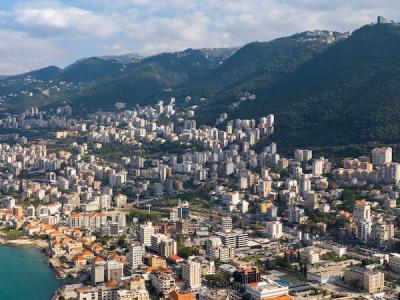In Lebanon's case, i.e. the Mediterranean climate, the evaluation of the degree of vulnerability can be based on the study of the two principal limiting factors: period of droughts and risk of frost. As summarized in Lebanon's First National Communication of 2 November 1999, expected impacts of climate change and adaptation measures are outlined for Lebanon's bioclimatic zones, water resources, agriculture, terrestrial ecosystems, coastal system, marine ecosystems and the socio-economic aspects of climate change.
Located on the eastern shore of the Mediterranean Sea between the North Latitudes 33o 03' 38" and 34o 41' 35" and East Longitude 35o 06' 22" and 36o 37' 22", Lebanon covers an area of 10,425 km2, with an average width of 48 km and average length of 220 km. In spite of its limited area, the Lebanese territory is dominated by two mountain ranges that run parallel to the sea (NNE-SSW) as well as to each other. The western range (Mount Lebanon) overlooks the narrow coastal plain and is separated from the eastern chain (the Anti-Lebanon) by the Bekaa Valley. This structure presents a variety of contrasting features, thus individualizing five major geomorphological regions with different ranges of altitude, slope and width.
The Coastal Zone including the shoreline, the coastal plain and the western chain foothills; The Mount Lebanon middle and high elevation zones; The Bekaa Plain (also called the Bekaa Valley); The Anti-Lebanon (including Jabal Al-Sheikh, also called Mount Hermon); The Southern Plateau (including Lebanese Upper Galilee and Jabal Amel). Another component of the Lebanese physical environment is to be given a special attention: the river system. With the exception of the Litani and the Assi, the Lebanese rivers run perpendicular to the general direction of the above-mentioned mountains. Added to the steep relief and the local lithology, the result is the formation of deeply incised valleys with particular climate conditions and specific riverbank vegetation.
Projects Completed
Latest Updates
See allLatest Publications
See allThe creation of a National Communication offers countries the opportunity to contribute with technically sound studies and information that can be…






